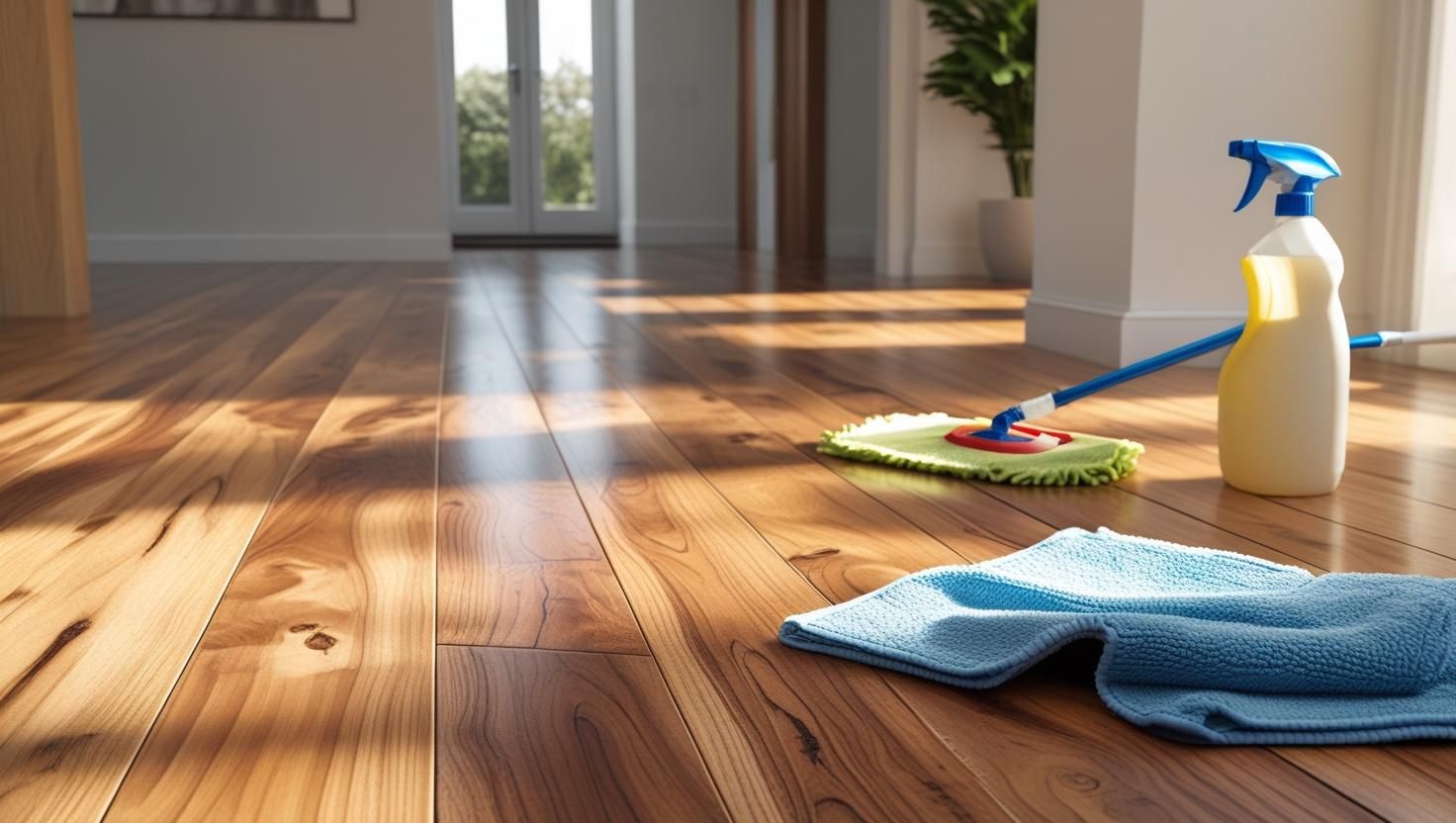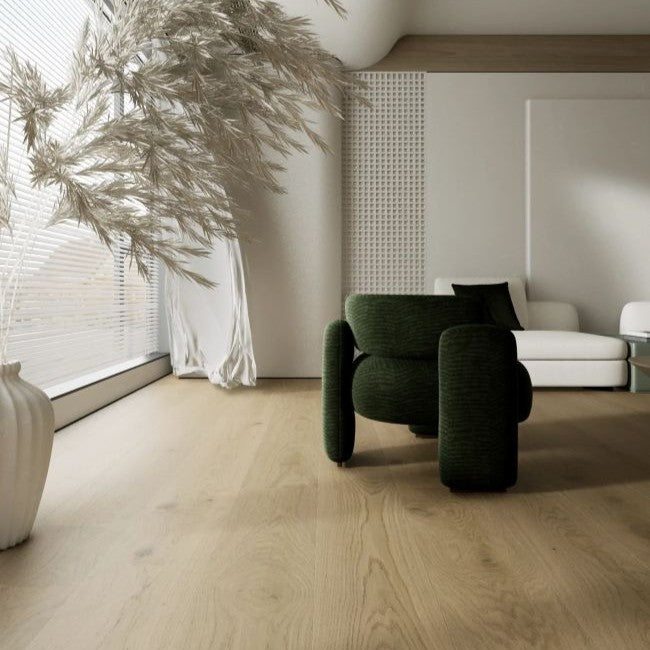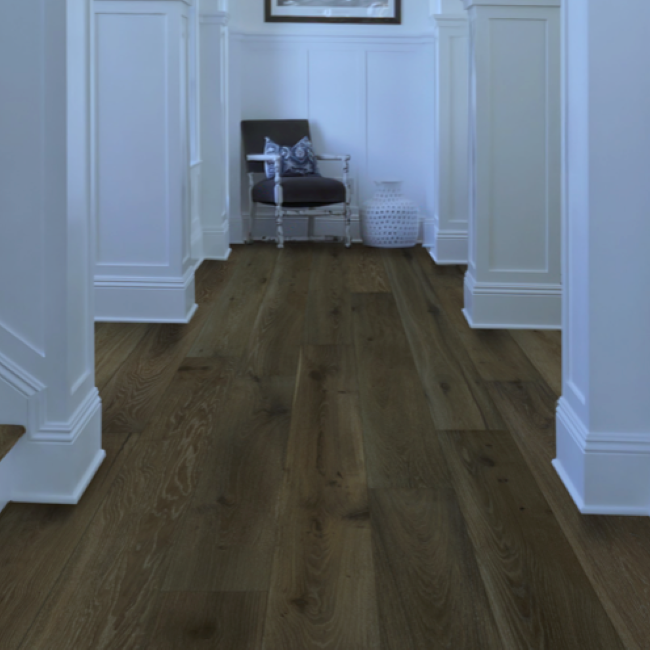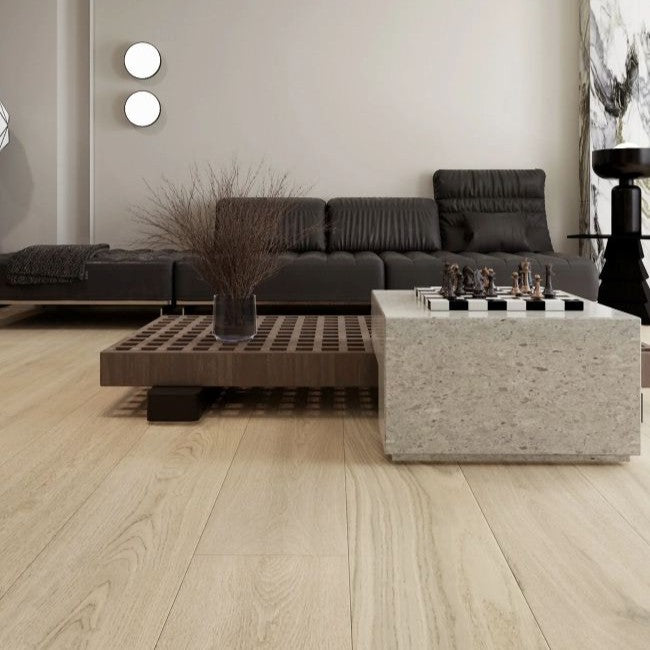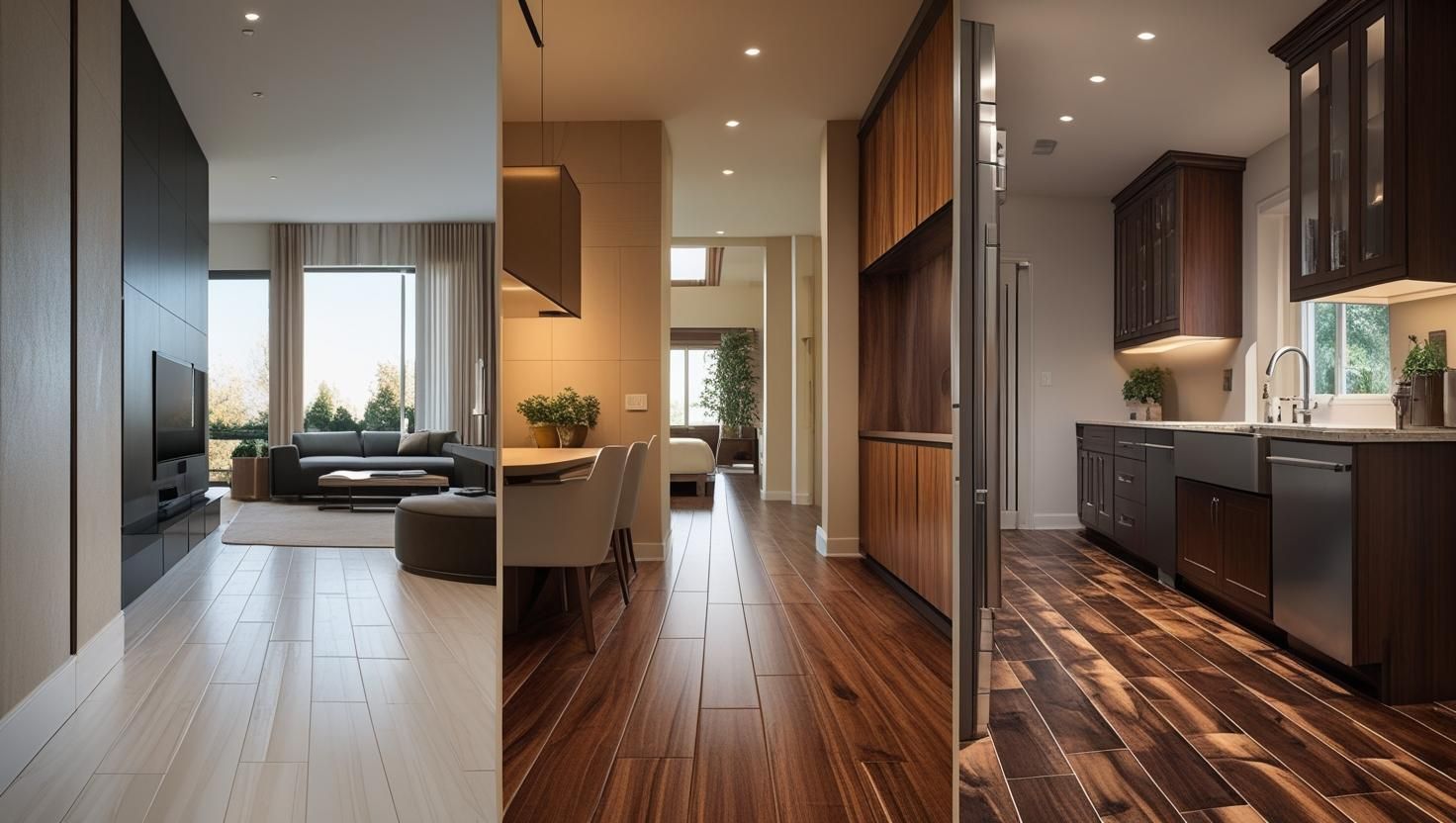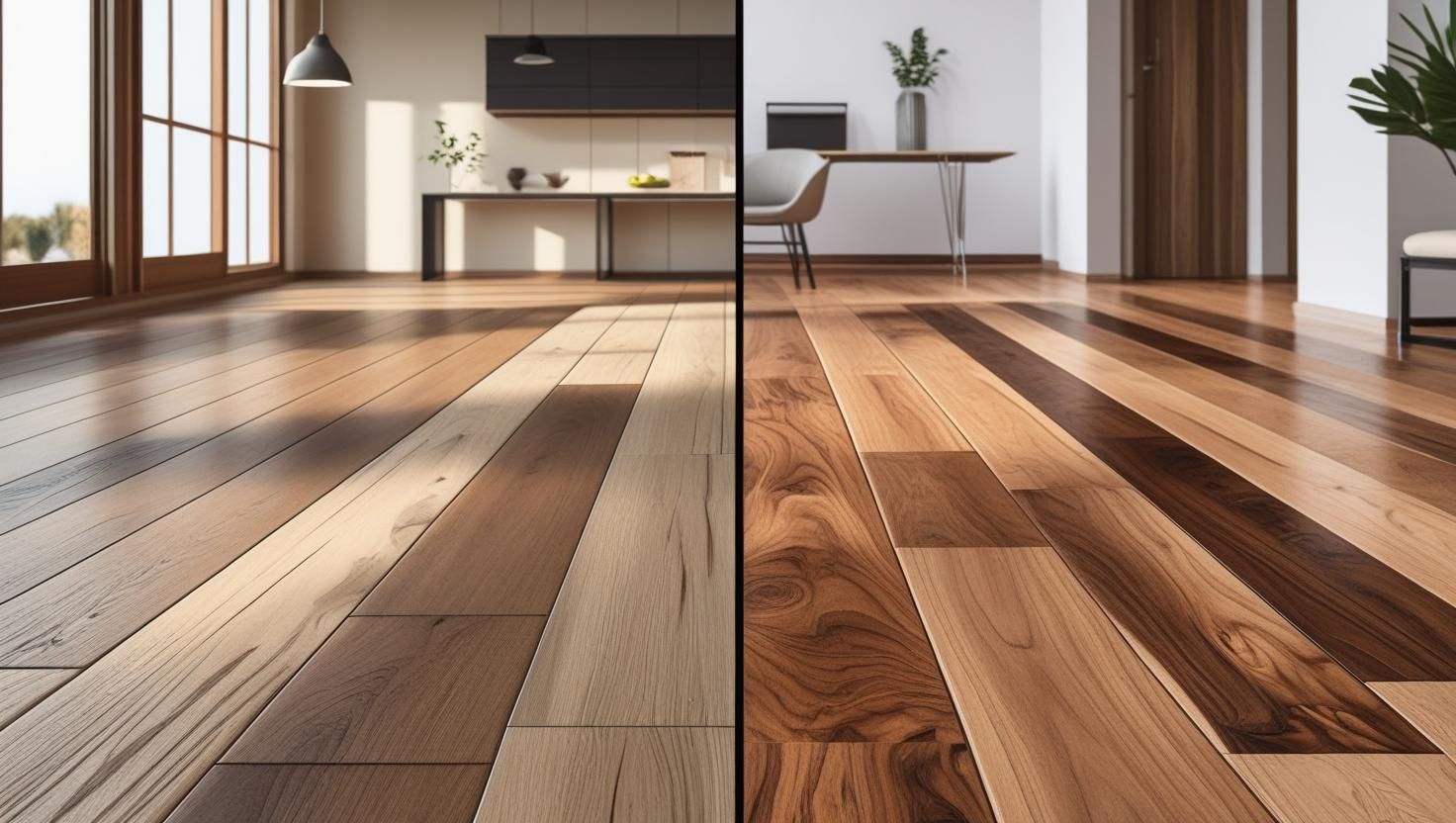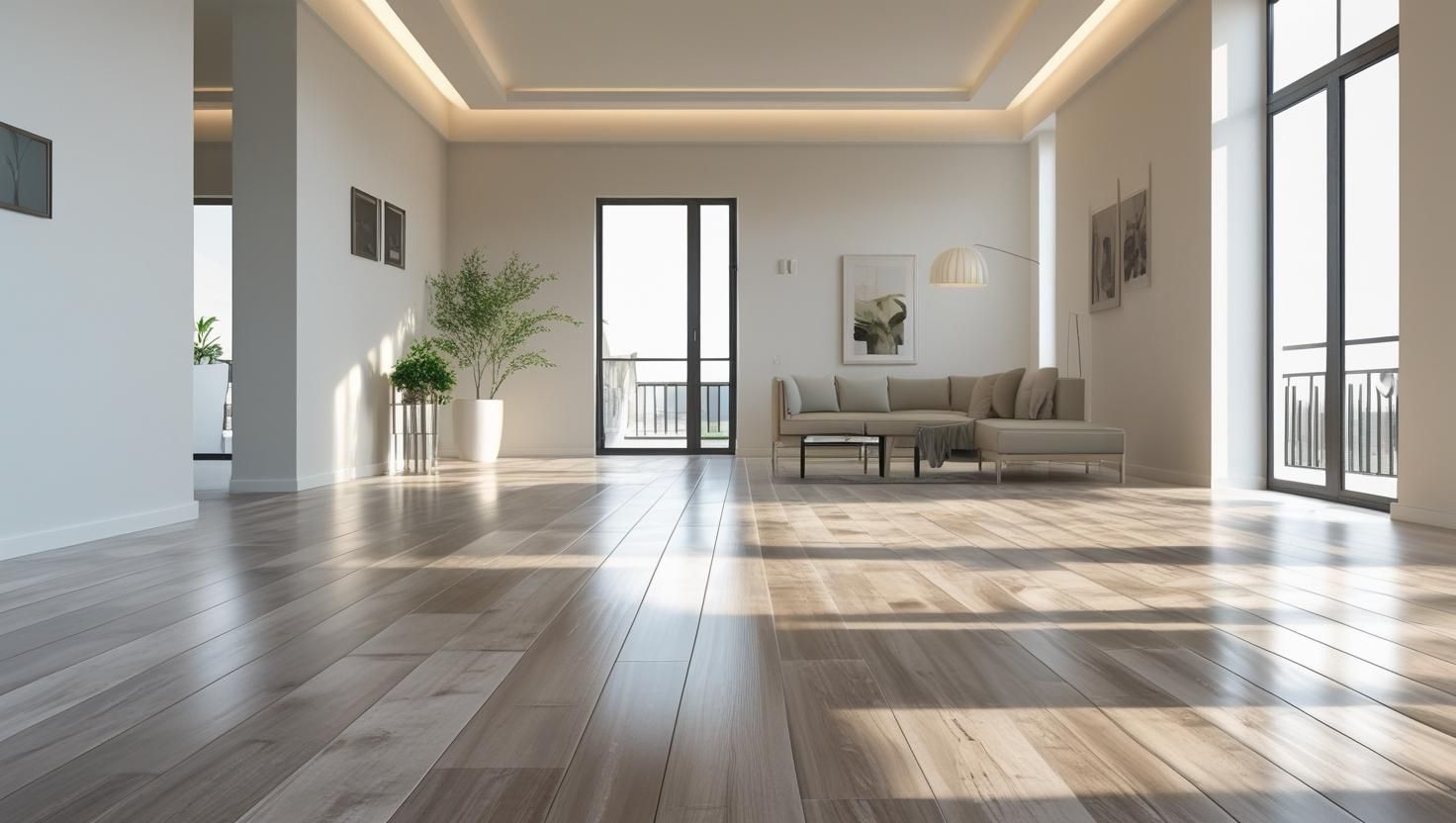You invested in engineered hardwood flooring because it’s beautiful, durable, and (supposedly) easier to maintain than traditional hardwood. But here you are dodging spills, suspecting every cleaning product, and wondering if your mop is actually the secret enemy of your floor.
Well, cleaning engineered hardwood floors is not just about keeping them “looking nice,” but about preserving the layered craftsmanship that makes it special, without damaging the top veneer, swelling the core, or dulling the finish. And with so much contradictory advice floating around online, it’s hard to know what actually works and what’s just clickbait.
In this guide, we are giving you real, practical steps on how to clean your engineered hardwood floors the right way.
Best Ways to Clean Engineered Wood Floors
You need an appropriate cleaning approach for your engineered hardwood floor to shine.
1. Check Your Floor’s Finish
Start by figuring out the finish on your engineered wood flooring; it makes a big difference in how you should clean it. Most floors like this come ready-made with a top coat already in place. That might be aluminum oxide, a UV-cured polyurethane, or acrylic urethane.
This covering protects the floor against day-to-day usage. But chemicals and excess moisture if not handled properly can damage your floor over time.
-
Floors coated with polyurethane are durable and water-resistant, but not waterproof. Using too much or the wrong cleaner can make the floor shiny or messy with a foggy appearance.
-
Less common oil-finished floors need special maintenance oils rather than regular ones.
Tip: Read the cleaning instructions, as they usually mention the specific brand and finish. Look up a flooring specialist or the manufacturer's site if you misplaced the manual.
Not sure which brand you have or what is best for your home? Check out our guide to the best engineered hardwood flooring brands for quality options worth your investment.
2. Weekly Damp Mopping
Dry cleaning and damp mopping are the safest and most effective cleaning methods for engineered hardwood flooring.
Dry Cleaning - Daily or as Needed
Debris like dust, pet hair, and sand seems to be harmless, but they are not. Your floor needs regular dry cleaning to prevent micro-scratches from developing.
- You can use a microfiber dust mop and an electrostatic broom, as they both trap fine dirt.
- Vacuuming is also effective, provided you use a model with a hard floor setting and turn off the beater bar. Use soft rubber wheels to prevent after marks.
Avoid upright vacuums with stiff brushes and rotating heads, as they scratch the veneer over time.
Damp Mopping - Once a Week or Spot Clean as Needed
While engineered wood is more resistant to moisture than solid hardwood, it still shouldn't be soaked. Damp mopping is ideal for removing stuck-on dirt or spills.
Use a microfiber mop that’s wrung out well; it should be damp, never wet.
A pH-neutral wood floor cleaner is an effective choice. Spray it directly onto the mop or the floor in small sections.
Work in small areas and dry immediately after with a clean cloth or mop.
Why this works: Moisture settling between the layers of engineered wood can cause the veneer to separate or warp. A condition called delamination.
3. Monthly or Seasonal Care
Even if you clean your engineered floor weekly, it still requires monthly cleaning for deeper care.
- Apply a wood floor polish or refresher specifically made for engineered flooring. These products restore luster without the need for refinishing.
- Apply with a flat microfiber pad.
- Do not skip the product’s instructions, try to follow them, and allow proper drying time.
Note: Only engineered floors with at least a 3mm veneer thickness can be sanded or refinished. But most standard versions cannot.
4. Twice-Yearly Polishing
To maintain the floor’s natural glow and protect it from surface wear, consider polishing your engineered wood floors every six months.
- Use a polish that’s labeled safe for engineered hardwood, (urethane-based polishes are often recommended).
- Clean the floor thoroughly before applying polish to prevent grit from embedding in the surface.
- Apply a thin, even coat using a flat pad applicator.
- Allow it to dry completely, typically 1 to 2 hours, before walking on it.
Important: Never use wax-based polish on polyurethane or aluminum oxide finishes, as it may leave a greasy residue or interfere with future recoating.
How to Care and Maintain Engineered Hardwood Flooring

Cleaning is important, but maintenance and care of your floor lessen your cleaning efforts. Preventive measures make your floor last for decades.
1. Sweep and Vacuum Your Floors Routinely
Engineered wood floors can lose their shine if dirt builds up. It doesn’t take much, just a little grit under your shoes can slowly scratch the surface like fine sand.
Sweep two or three times every week with a soft broom. A canister vacuum is a good pick, as long as it’s made for wood floors with soft wheels and no beater bar. Never use machines with spinning brushes or beater bars; they can scratch or wear down the finish. If pets or kids are around often, it’s worth sweeping daily to keep things clean.
Tip: Go for vacuums that roll on rubber wheels so they don’t leave tracks or scuffs. If you have a robot vacuum, make sure it has a way to turn off the brush before using it.
2. Microfiber Mop to Remove Debris
After you've cleared the loose dirt, the next step is to remove smaller dust particles and any remaining film.
Microfiber mops are ideal for this purpose; they clean without scratching or leaving streaks behind. For deep cleaning, use a damp microfiber mop.
Don’t forget to squeeze out extra water.
Tip: Always use a cleaner that’s pH-neutral or clearly labeled safe for engineered wood. Steer clear of vinegar, ammonia, or soap-based cleaners. These can ruin the floor’s finish and cause a dull film.
3. Spill Management
Kids and pets make life fun, but sometimes messy. It’s normal for accidents to happen, and engineered wood flooring is built to take it, if you act fast.
Use a soft cloth to blot up spills right away. Press gently. Don’t scrub hard; that only pushes the liquid deeper or wears down the finish. A barely damp microfiber cloth with a touch of cleaner usually clears up the sticky stuff or dried spots.
Important Note: Though the surface has a sealed hardwood layer, too much moisture left sitting can cause swelling, stains, or worse, peeling of the layers beneath.
4. Moisture Management
Even though engineered hardwood handles moisture better than solid wood, it’s still vulnerable to damage if exposed for too long.
Learn the difference between engineered and natural hardwood flooring.
Standing water, high humidity, or steam can lead to swelling, warping, or delamination of the top veneer of engineered hardwood floors. Here’s how to stay on top of moisture management:
- Place mats or rugs in front of entry doors, near sinks, and any area where water is often present. Pick ones that breathe well and skip anything with a rubber back. That kind holds in dampness.
- Keep your home’s humidity between 35% and 55%. You might need a humidifier or dehumidifier, depending on your space.
- Avoid using steam mops or soaking the floor with water. Water can seep into seams and under layers; it may ruin your floor for good.
Bonus tip: Follow your flooring brand’s specific cleaning recommendations. Some floors have a special coating or layer that needs different care.
5. Seasonal Adjustments
Temperature and humidity changes cause engineered wood floors to move a little. While it’s usually not a big deal, when seasons shift, like dry winters turning into sticky summers, you might hear a soft creak or notice small gaps between the boards.
To reduce the seasonal movement:
- Use a hygrometer to monitor room humidity.
- In the winter, run a humidifier to combat dry indoor air.
- In humid climates or rainy seasons, ensure your air conditioner or dehumidifier is running efficiently.
This proactive care keeps your floor stable and helps prevent long-term structural damage like warping or cupping.
There are plenty of long-lasting options on the market that only need minimal but careful upkeep.
Best Cleaners for Engineered Wood Floors
A safe and neutral cleaner choice is important to keep your floor scratch-free.
1. pH-Neutral Wood Floor Cleaner
A pH-neutral cleaner is the safest and most versatile option for engineered wood. These cleaners are specifically formulated to maintain the floor's top protective layer without stripping away oils or finishes.
Engineered floors are sensitive to high acidity or alkalinity. A neutral pH (around 7) ensures the surface isn’t damaged, discolored, or dulled.
Best used for: Routine weekly cleaning using a damp microfiber mop.
2. Vinegar-Diluted Solution (Only with Proper Ratio)
A very mild vinegar solution is a natural cleaner, used occasionally for deeper cleaning when floors feel greasy or cloudy, but with extreme care.
Vinegar helps dissolve grime, hard water marks, and residue naturally.
Vinegar is acidic, so it must be heavily diluted (e.g., 1/2 cup per gallon of water). Never use it undiluted or frequently, as it can dull the finish over time.
Best used for: Occasional deep cleans, not daily maintenance.
3. Enzyme-Based Natural Cleaners
These plant-based cleaners break down organic dirt and grime on a molecular level without harsh chemicals.
Enzyme cleaners gently dissolve food spills, pet messes, and sticky spots while remaining non-toxic and biodegradable.
Best used for: Spot treatment in homes with pets or kids, especially in high-traffic areas.
Natural Way to Clean Engineered Hardwood Floors (DIY Cleaner)
Many commercial cleaners contain harsh chemicals that can dull your floor’s shine over time, so opt for the natural way to clean engineered hardwood floors. For a better and safer option, you can make your own DIY cleaner, which is affordable and effective as well.
Ingredients to make your floor cleaner
- 1 gallon of warm distilled water
- ½ cup of white distilled vinegar
- 5–10 drops of essential oil (e.g., lavender, lemon, or tea tree – optional, for scent)
- A spray bottle or mop bucket
- Add 1 tablespoon of isopropyl alcohol for faster drying (Optional)
Instructions
- The first thing you need to do is mix all ingredients in a bucket or spray bottle.
- For a better mixture, shake gently. Especially if using essential oils, shake them well.
- Now, spray the cleaner onto your microfiber mop or directly on the floor in small sections.
- Mop gently and dry the area with a clean cloth. And allow the floor to air-dry.
What Not to Do When Cleaning Engineered Hardwood
Avoid some adverse practices and materials to keep your floor glossy as it was newly installed.
1. Excess Water or Steam Cleaning
Engineered wood may be more moisture-resistant than solid hardwood, but it’s still not waterproof. Using too much water or cleaning with a steam mop can cause:
- Swelling of the core layers (usually plywood or HDF)
- Delamination or warping of the veneer
- Finish breakdown over time
2. Harsh Chemicals and Abrasive Cleaners
Ammonia, bleach, or abrasive powders strip the finish of your floor. It also dulls the top layer of your engineered flooring.
- These harsh chemicals damage polyurethane or aluminum oxide finishes
- They also leave residues that attract more dirt and grime
- Abrasives can cause micro-scratches that reduce shine and weaken the wear layer
3. Rough Cleaning Tools
Tools like stiff-bristled brushes, scouring pads, or hard plastic scrubbers do not prove a good cleaning material as they scratch the floor’s surface. This is even more obvious if the floor has a thinner veneer.
- These tools grind dirt into the finish instead of lifting it
- Once scratched, engineered wood is harder to refinish than solid wood due to its thinner top layer
FAQs
Why does my floor look streaky or dull after cleaning?
Too much use of cleaner/water that is too hard, or the wrong products, can cause engineered hardwood floors to look streaky or cloudy. Swap to a pH-neutral cleaner and buff with a dry microfiber cloth.
How often should you clean engineered wood floors?
Sweeping or vacuuming 2–3 times per week to remove dust and debris is an ideal routine. Also, mop with a damp mop weekly, but use a pH-neutral cleaner for a more thorough cleaning.
The Bottom Line
Engineered hardwood doesn’t ask for much, just the right kind of attention. And now that you know what actually works (and what doesn’t), you’re in a better position to protect what you have invested in.
Use the right tools, clean smart, and let your floor look great and last long. And when in doubt? Less water. Softer cloth. Smarter choices.
Call (833) 378-4559 to talk to our flooring expert and get the best advice.


